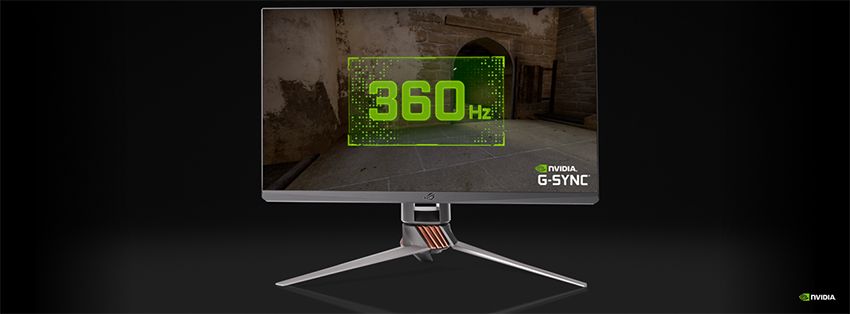NVIDIA Announces New G-SYNC Esports Displays at CES 2020, with Breakthrough 360Hz Design
Inhuman reactions, outplays, and godlike aim are what keep esports fans at the edge of their seat. At NVIDIA, we’re committed to helping esports athletes and competitive gamers unlock their potential and hit those unbelievable shots. Today, we’re announcing the world's fastest esports display, running at 360Hz, powered by NVIDIA G-SYNC.
Our partners at ASUS have implemented this technology, together with AU Optronics’s panel, in the ASUS ROG Swift 360Hz esports display. This no compromises display offers a 360Hz refresh rate for unparalleled smoothness, lower system latency for faster reaction times, and a 24.5 inch 1080p form factor to keep every pixel of action in your field of view.
n0thing, five-time CS:GO Champion said, “When I switched between 240 and 360, I could immediately tell that there was a difference”, after experiencing the smoothness and clarity of 360Hz gaming for the first time. Adding, “This display is great for gamers who want to maximize their potential.”
First introduced in 2013, NVIDIA G-SYNC is best known for its innovative Variable Refresh Rate technology that eliminates tearing by synchronizing the refresh rate of the display with the GPU’s frame rate. Since then, G-SYNC processors have added new display technologies to accelerate esports panels, including dynamic overdrive to enhance player perception, custom-tuned firmware to improve image quality for better target acquisition, and now 360Hz refresh rates for rapid reaction time.
While esports pros previously accepted frame tearing on their display in order to avoid waiting for the next frame to update, with G-SYNC’s 360Hz and Variable Refresh Rate technologies, frames refresh so fast--in less than 3ms--esports pros can get both tear-free frames and incredibly low latency.
NVIDIA’s focus on delivering industry leading esports products has been guided by deep research in understanding the relationship between PC technology and player competitiveness. Over the last few years, our research team has conducted studies to understand how FPS, Hz, and system latency affect aiming tasks in first person shooters. Based on our research, which was published at SIGGRAPH ASIA in November 2019, we found that higher FPS/HZ and lower system latency makes a significant difference:
End to end system latency measured in ms using click to photon response time in Overwatch. Source: NVIDIA
This isn’t a GPU performance chart -- this is a raw player skill benefit. In the world of competitive sports, a 4% difference is a game changer. To put this into context, in the 2016 Summer Olympics, 1% determined the difference between silver and gold in both men’s and women’s 100m and 200m dashes.
Counter-Strike: Global Offensive, Rainbow Six: Siege, Overwatch, and Fortnite are just a few of the competitive games that can achieve 360 FPS on GeForce RTX hardware, enabling gamers to take full advantage of the new 360Hz displays, and to benefit from the improvements our research found.
To demonstrate the clarity and enhanced perception of our new 360Hz display technology, we partnered with BlurBusters, a website that’s been helping people get crisper gaming experiences for over a decade.
Head here to see and try the demo
This demo uses images from DOTA 2 to help illustrate the clarity benefits 360Hz provides. As the image scrolls past, the scene, nameplates, and all the action is much much clearer at 360Hz, making it far easier to stay focused on your opponents.
360Hz also helps you get on target faster by reducing system latency and improving target acquisition through increased display clarity. We worked with Yesber from YPRAC to create an aiming task that showcases these benefits. The objective of this aiming task is to find and eliminate as many targets as possible in 45 seconds. The targets appear out of your field of view, so you will be forced to rotate and find them - combining target acquisition with aiming skills.
We know that the benefits are not as easily seen online when watching a video, as was the case with HDR and VRR, which is why we’ve taken our suite of 360Hz demos to CES, enabling tech press and partners from around the world to experience this technology for themselves.
Look for coverage from your favorite channels and websites over the coming week and stay tuned for more information on pricing and availability for the ASUS ROG Swift 360Hz G-SYNC display coming later this year.


